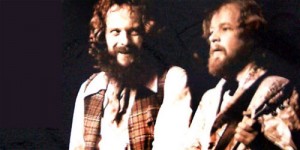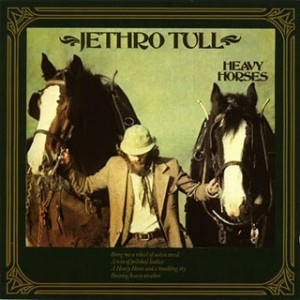
Meanwhile back in the year…1978?
It was the best of times; it was the worst of times. The progressive rock monolith (immortalized, or infamous, from the cover of Emerson, Lake and Palmer’s Tarkus… or the cover of any Yes album) was lurching toward its bloated end-game. This was unfortunate, or overdue, depending upon your perspective. If punk rock did not quite reign supreme, there was no question that its DIY ethos was gaining steam. If one image (besides a disco ball) could express the disfavor the stadium-rock old guard was falling into, consider the (calculated) mileage Johnny Rotten received for scrawling “I Hate” above his Pink Floyd t-shirt. Pretense, all of a sudden, was anathema—and if the cash registers were still clanking, they would be replaced by synthesizer sounds and round-the-clock music videos in short order.
Back to basics? How about back to the 18th Century? That is the vibe Jethro Tull was emanating circa 1978. The band that dropped not one, but two single-song album suites (ingenious or insufferable, depending upon your perspective), had evolved into a proficient troop of professionals that incorporated strings, lutes, fifes and harpsichords into their repertoire. Beginning in 1975, with less irony than some might assume, Tull released consecutive albums entitled Minstrel in the Gallery and Too Old To Rock and Roll; Too Young To Die!. Then, as if doubling down on their never hip (but, to their credit, never affected) sensibility, they released Songs From The Wood (’77) and Heavy Horses.

To put more plainly, the same years The Clash, The Ramones and The Sex Pistols were establishing a radically new and brazen rock aesthetic, Ian Anderson appeared on an album cover flanked by two Clydesdales. Out of time and possibly out of touch (but still remarkably successful, for all the right reasons), Jethro Tull were, first and foremost, a band for people who craved intelligent and occasionally challenging music, played convincingly by exceptional musicians. How quaint.
In any event, it was while touring for the recently released Heavy Horses (the title track being a prescient—and unironic!—tribute to the working horses of England who, much like prog rock, were soon to step aside; their demise having less to do with trends and tastemakers than technology) that the band had the privilege of transmitting a show live, via satellite, from New York City to Britain. That Jethro Tull was the band selected for this historic occasion should adequately signify how huge they were at that time. Not for nothing (even though 1980 and alas, a new line-up ushering in a lesser era lurked unknowingly, just ‘round the corner), this was arguably Tull’s ultimate cast of characters.
The band, including mostly unheralded drummer Barriemore Barlow and the brilliant keyboardist John Evan, along with David Palmer (arranger/keyboardist) and Tony Williams (gamely filling in for bassist John Glascock, who would pass away a short time later at the absurdly young age of 28) as well as Anderson’s right hand man, lead guitarist Martin Barre, were a force to be reckoned with. These lads brought the noise—so to speak—in the studio and were quite capable of recreating their material on stage.
And the above point gets to the heart of the matter in regards to the merits of this new release. For a band that has toured almost ceaselessly for four decades (!), there is painfully little footage available of Tull in their prime. The year 1978, then, finds them suitably confident and eager for the occasion, and they acquit themselves with flying colors. The DVD, like the gig, was necessarily unorthodox: the satellite feed was transmitted to UK households watching The Old Grey Whistle Test. As such, the band was obliged to play a three song “warm up” (seen only by the live audience at Madison Square Garden), then re-start the concert, play until the allotted time ran out, “end” the show and then come back out for several more songs (again only seen by the live crowd).
This detail is intriguing not only as back-story but to marvel at how incredibly far we’ve come, technologically speaking, in only a few decades. The evening’s performance is included on this DVD, which generously includes a bonus CD with the same tracks (a fact that should elevate this offering from interesting to imperative for Tull fans).
The show itself is quite satisfactory: Ian Anderson, ever the showman, may have slowed down a step from his “Mad Dog Fagin” days, but he—and the rest of the band—is still fit, trim and full of fire. The highlight of the concert (and the “opening song” for the UK audience) must be “Thick As A Brick” which represents (at least for now) the definitive live version of this extraordinary tune.
The recent albums are nicely represented with spirited takes on “Songs From The Wood” (wherein the audience is literally challenged to “join the chorus if (they) can”), “Heavy Horses” and “No Lullaby”. As always, the band is obliged to perform crowd favorites “Aqualung” (which never translates particularly well live) and “Locomotive Breath” (which does), and there are some pleasant surprises such as “My God” and “One Brown Mouse”.
Live At Madison Square Garden 1978 is indeed a very worthwhile—and somewhat overdue—addition to the Tull catalog, and hopefully this signals an imminent willingness to explore the vaults for more (preferably even earlier) material.
